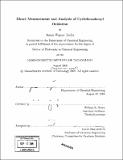Direct measurement and analysis of cyclohexadienyl oxidation
Author(s)
Taylor, James Wagner
DownloadFull printable version (6.400Mb)
Other Contributors
Massachusetts Institute of Technology. Dept. of Chemical Engineering.
Advisor
William H. Green.
Terms of use
Metadata
Show full item recordAbstract
The oxidation of cyclohexadienyl radical (c-C₆H₇) and similar resonantly stabilized radicals are important in an astonishing array of processes in nature. Cyclohexadienyl radical has been postulated to be significant in a variety of processes that involve the atmospheric formation of benzene. In biology, there are specific enzymes that promote the formation of benzene-like intermediates from cyclohexadienyl radicals, called cyclohexadienyl dehydratases. In combustion processes, cyclohexadienyl radical is a possible link to the formation of soot and other large polyaromatic hydrocarbons (PAH's). Thus, the cyclohexadienyl radical moiety is important in many chemical processes, and its detailed study is of interest in many areas. In this work, cyclohexadienyl radical is studied both computationally and experimentally in the liquid and gas phases. The cyclohexadienyl radical is created using laser-flash photolysis. The UV absorption bands of the radical are probed and it's relative concentration over time measured in non-polar solvents in both the presence and absence of oxygen. Several analytical and numerical models of the chemistry were constructed to explain a puzzling discrepancy in the reported liquid and gas phase reaction rates. (cont.) The models and data developed were then used in testing new software for finding the global optimum of dynamic systems. Optimized parameters for several key reaction pathways are reported, as well as a detailed description of the procedure. Finally, c-C₆H₇ was studied in the gas phase using an ultra-fast laser system. Preliminary results from those experiments are reported, as well as recommendations for future work.
Description
Thesis (Ph. D.)--Massachusetts Institute of Technology, Dept. of Chemical Engineering, 2005. Includes bibliographical references (p. 173-182).
Date issued
2005Department
Massachusetts Institute of Technology. Department of Chemical EngineeringPublisher
Massachusetts Institute of Technology
Keywords
Chemical Engineering.